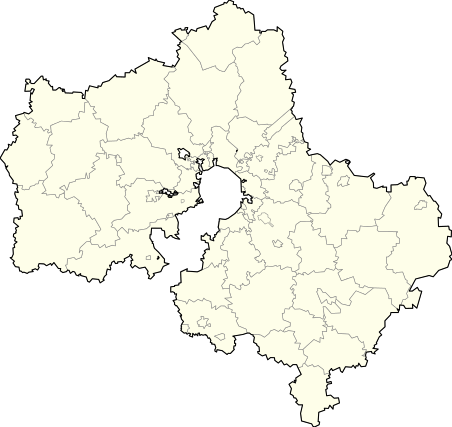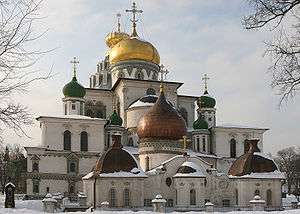Zvenigorod
| Zvenigorod (English) Звенигород (Russian) | |
|---|---|
| - Town[1] - | |
 The Moskva River in Zvenigorod | |
.svg.png) Location of Moscow Oblast in Russia | |
 Zvenigorod | |
|
| |
| Administrative status (as of January 2013) | |
| Country | Russia |
| Federal subject | Moscow Oblast[1] |
| Administratively subordinated to | Zvenigorod Town Under Oblast Jurisdiction[1] |
| Administrative center of | Zvenigorod Town Under Oblast Jurisdiction[1] |
| Municipal status (as of February 2010) | |
| Urban okrug | Zvenigorod Urban Okrug[2] |
| Administrative center of | Zvenigorod Urban Okrug[2] |
| Statistics | |
| Area | 48.1 km2 (18.6 sq mi) |
| Population (2010 Census) | 16,395 inhabitants[3] |
| Density | 341/km2 (880/sq mi)[4] |
| Time zone | MSK (UTC+03:00)[5] |
| First mentioned | 1338 |
| Town status since | 1784 |
| Dialing code(s) | +7 49869 |
| Zvenigorod on Wikimedia Commons | |

Zvenigorod (Russian: Звени́город) is an old town in Moscow Oblast, Russia. Population: 16,395 (2010 Census);[3] 12,155 (2002 Census);[6] 15,805 (1989 Census).[7]
History
The community has existed since the 12th century, although its first written mention is dated 1338. The town's name is based either on a personal name (cf. Zvenislav, Zvenimir) or on a hydronym (cf. the Zvinech, Zvinyaka, Zveniga Rivers); the derivation from "town of ringing (bells)" is a folk etymology.[8]
Zvenigorod rose to prominence in the late 14th century after it was bequeathed by Dmitry Donskoy to his second son Yuri, who founded his residence on the steep bank of the Moskva River. The local kremlin, called Gorodok, contains the only fully preserved example of 14th-century Muscovite architecture, the Assumption Cathedral (1399) (Cathedral of the Dormition of the Holy Virgin Mary; in Russian: Успенский собор на Городке). The cathedral's interior features frescoes by Andrei Rublev.

Zvenigorod is primarily remembered for internecine wars waged by Yuri's sons for control of Moscow during the reign of their cousin Vasily II (1425–1462). After their party was defeated, the town was incorporated into the Grand Duchy of Moscow.
Zvenigorod was granted town rights in 1784. By the late 19th century, the town gained popularity among the intelligentsia as a fashionable banlieue of Moscow. Many extravagant dachas were built in the neighbourhood. Some of these house museums of Sergey Taneyev, Anton Chekhov, and Isaac Levitan.
Savvino-Storozhevsky Monastery

In 1398, Prince Yury asked St. Savva, one of the first disciples of Sergius of Radonezh, to go to Zvenigorod and to establish a monastery on the Storozhi Holm (Watching Hill). St. Savva of Storozhi was interred in the white stone cathedral of the Virgin's Nativity in 1407. This diminutive, roughly hewn church still stands, although its present-day exquisite look is the result of recent restoration. The frescoes in the altar date back to the 1420s, but the rest of interior was painted in 1656. A magnificent iconostasis in five tiers and the Stroganov-school heaven gates were installed in 1652.
In 1650, the monastery was chosen by Tsar Alexis as his suburban residence. In five years, they constructed a white-stone royal palace and a festive chamber for tsaritsa. The cloister was encircled with stone walls and towers, patterned after those of the Trinity Lavra of St. Sergius. Particularly noteworthy is a large belfry, erected in four bays in 1650 and crowned with three tents and a clocktower. A church over the holy gates was consecrated to the Holy Trinity in 1652.
After the death of Feodor III, who spent most of his time there, the monastery declined. In May 1918, when the Bolsheviks tried to seize the relics of St. Savva, several persons were shot dead. In 1985, the cloister was assigned to the Danilov Monastery in Moscow. St. Savva's relics were returned to the monastery in 1998.
Administrative and municipal status
Within the framework of administrative divisions, it is incorporated as Zvenigorod Town Under Oblast Jurisdiction—an administrative unit with the status equal to that of the districts.[1] As a municipal division, Zvenigorod Town Under Oblast Jurisdiction is incorporated as Zvenigorod Urban Okrug.[2]
International relations
Twin towns — Sister cities
Zvenigorod is twinned with:
References
Notes
- 1 2 3 4 5 Law #11/2013-OZ
- 1 2 3 Law #36/2005-OZ
- 1 2 Russian Federal State Statistics Service (2011). "Всероссийская перепись населения 2010 года. Том 1" [2010 All-Russian Population Census, vol. 1]. Всероссийская перепись населения 2010 года (2010 All-Russia Population Census) (in Russian). Federal State Statistics Service. Retrieved June 29, 2012.
- ↑ The value of density was calculated automatically by dividing the 2010 Census population by the area specified in the infobox. Please note that this value may not be accurate as the area specified in the infobox does not necessarily correspond to the area of the entity proper or is reported for the same year as the population.
- ↑ Правительство Российской Федерации. Федеральный закон №107-ФЗ от 3 июня 2011 г. «Об исчислении времени», в ред. Федерального закона №271-ФЗ от 03 июля 2016 г. «О внесении изменений в Федеральный закон "Об исчислении времени"». Вступил в силу по истечении шестидесяти дней после дня официального опубликования (6 августа 2011 г.). Опубликован: "Российская газета", №120, 6 июня 2011 г. (Government of the Russian Federation. Federal Law #107-FZ of June 31, 2011 On Calculating Time, as amended by the Federal Law #271-FZ of July 03, 2016 On Amending Federal Law "On Calculating Time". Effective as of after sixty days following the day of the official publication.).
- ↑ Russian Federal State Statistics Service (May 21, 2004). "Численность населения России, субъектов Российской Федерации в составе федеральных округов, районов, городских поселений, сельских населённых пунктов – районных центров и сельских населённых пунктов с населением 3 тысячи и более человек" [Population of Russia, Its Federal Districts, Federal Subjects, Districts, Urban Localities, Rural Localities—Administrative Centers, and Rural Localities with Population of Over 3,000] (XLS). Всероссийская перепись населения 2002 года [All-Russia Population Census of 2002] (in Russian). Retrieved August 9, 2014.
- ↑ Demoscope Weekly (1989). "Всесоюзная перепись населения 1989 г. Численность наличного населения союзных и автономных республик, автономных областей и округов, краёв, областей, районов, городских поселений и сёл-райцентров" [All Union Population Census of 1989: Present Population of Union and Autonomous Republics, Autonomous Oblasts and Okrugs, Krais, Oblasts, Districts, Urban Settlements, and Villages Serving as District Administrative Centers]. Всесоюзная перепись населения 1989 года [All-Union Population Census of 1989] (in Russian). Институт демографии Национального исследовательского университета: Высшая школа экономики [Institute of Demography at the National Research University: Higher School of Economics]. Retrieved August 9, 2014.
- ↑ Е. М. Поспелов. Географические названия мира (Москва: Русские словари, 1998), p. 160.
Sources
- Московская областная Дума. Закон №11/2013-ОЗ от 31 января 2013 г. «Об административно-территориальном устройстве Московской области», в ред. Закона №72/2015-ОЗ от 5 мая 2015 г. «Об отнесении города Озёры Озёрского района Московской области к категории города областного подчинения Московской области, упразднении Озёрского района Московской области и внесении изменений в Закон Московской области "Об административно-территориальном устройстве Московской области"». Вступил в силу на следующий день после официального опубликования (13 января 2013 г.). Опубликован: "Ежедневные Новости. Подмосковье", №24, 12 февраля 2013 г. (Moscow Oblast Duma. Law #11/2013-OZ of January 31, 2013 On the Administrative-Territorial Structure of Moscow Oblast, as amended by the Law #72/2015-OZ of May 5, 2015 On Re-Classifying the Town of Ozyory in Ozyorsky District of Moscow Oblast as the Town Under Oblast Jurisdiction, on Abolishing Ozyorsky District of Moscow Oblast, and on Amending the Law of Moscow Oblast "On the Administrative-Territorial Structure of Moscow Oblast". Effective as of the day following the day of the official publication (January 13, 2013).).
- Московская областная Дума. Закон №36/2005-ОЗ от 3 февраля 2005 г. «О статусе и границе городского округа Звенигорд», в ред. Закона №12/2010-ОЗ от 26 февраля 2010 г «О внесении изменений в Закон Московской области "О статусе и границе городского округа Звенигород" и Закон Московской области "О статусе и границах Одинцовского муниципального района и вновь образованных в его составе муниципальных образований"». Вступил в силу со дня официального опубликования. Опубликован: "Ежедневные Новости. Подмосковье", №26, 12 февраля 2005 г. (Moscow Oblast Duma. Law #36/2005-OZ of February 3, 2005 On the Status and the Border of Zvenigorod Urban Okrug, as amended by the Law #12/2010-OZ of February 26, 2010 On Amending the Law of Moscow Oblast "On the Status and the Border of Zvenigorod Urban Okrug" and the Law of Moscow Oblast "On the Status and the Borders of Odintsovsky Municipal District and the Newly Established Municipal Formations It Comprises". Effective as of the day of the official publication.).
External links
- Unofficial website of Zvenigorod (Russian)
- Photo of Savvino-Storozhevsky monastery
- Photo of the Moskva River near Zvenigorod
- About St. Savva Storozevsky and Zvenigorod in the book in a series "Life of outstanding people" by K. Kovalev
